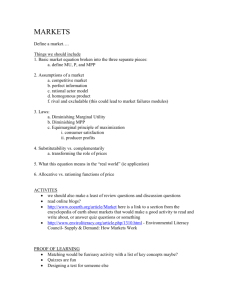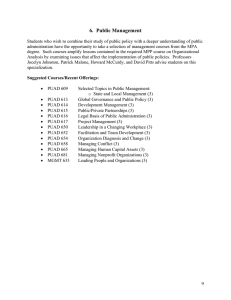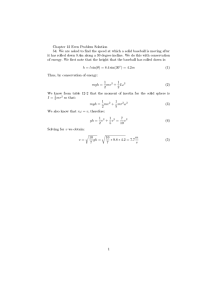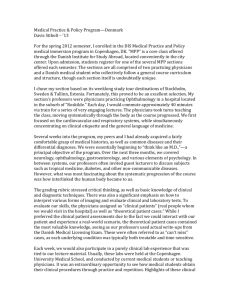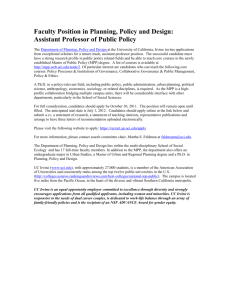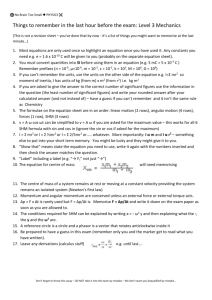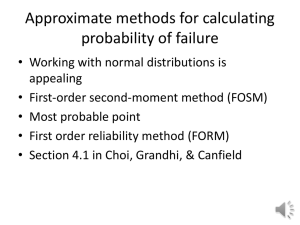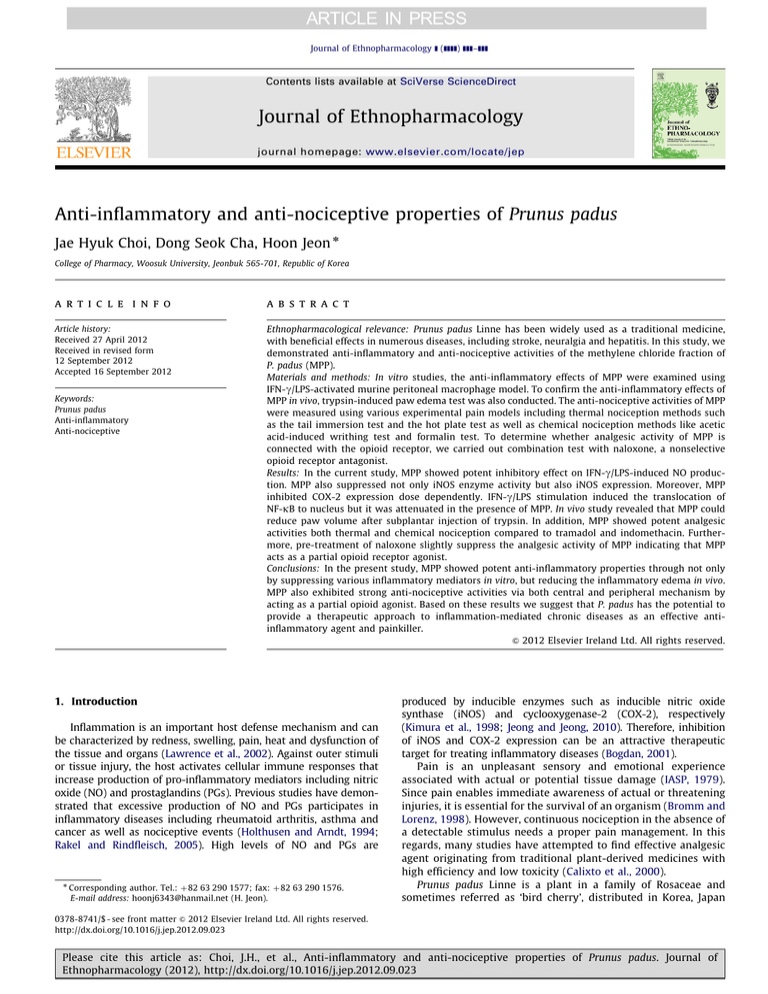
Journal of Ethnopharmacology ] (]]]]) ]]]–]]]
Contents lists available at SciVerse ScienceDirect
Journal of Ethnopharmacology
journal homepage: www.elsevier.com/locate/jep
Anti-inflammatory and anti-nociceptive properties of Prunus padus
Jae Hyuk Choi, Dong Seok Cha, Hoon Jeon n
College of Pharmacy, Woosuk University, Jeonbuk 565-701, Republic of Korea
a r t i c l e i n f o
abstract
Article history:
Received 27 April 2012
Received in revised form
12 September 2012
Accepted 16 September 2012
Ethnopharmacological relevance: Prunus padus Linne has been widely used as a traditional medicine,
with beneficial effects in numerous diseases, including stroke, neuralgia and hepatitis. In this study, we
demonstrated anti-inflammatory and anti-nociceptive activities of the methylene chloride fraction of
P. padus (MPP).
Materials and methods: In vitro studies, the anti-inflammatory effects of MPP were examined using
IFN-g/LPS-activated murine peritoneal macrophage model. To confirm the anti-inflammatory effects of
MPP in vivo, trypsin-induced paw edema test was also conducted. The anti-nociceptive activities of MPP
were measured using various experimental pain models including thermal nociception methods such
as the tail immersion test and the hot plate test as well as chemical nociception methods like acetic
acid-induced writhing test and formalin test. To determine whether analgesic activity of MPP is
connected with the opioid receptor, we carried out combination test with naloxone, a nonselective
opioid receptor antagonist.
Results: In the current study, MPP showed potent inhibitory effect on IFN-g/LPS-induced NO production. MPP also suppressed not only iNOS enzyme activity but also iNOS expression. Moreover, MPP
inhibited COX-2 expression dose dependently. IFN-g/LPS stimulation induced the translocation of
NF-kB to nucleus but it was attenuated in the presence of MPP. In vivo study revealed that MPP could
reduce paw volume after subplantar injection of trypsin. In addition, MPP showed potent analgesic
activities both thermal and chemical nociception compared to tramadol and indomethacin. Furthermore, pre-treatment of naloxone slightly suppress the analgesic activity of MPP indicating that MPP
acts as a partial opioid receptor agonist.
Conclusions: In the present study, MPP showed potent anti-inflammatory properties through not only
by suppressing various inflammatory mediators in vitro, but reducing the inflammatory edema in vivo.
MPP also exhibited strong anti-nociceptive activities via both central and peripheral mechanism by
acting as a partial opioid agonist. Based on these results we suggest that P. padus has the potential to
provide a therapeutic approach to inflammation-mediated chronic diseases as an effective antiinflammatory agent and painkiller.
& 2012 Elsevier Ireland Ltd. All rights reserved.
Keywords:
Prunus padus
Anti-inflammatory
Anti-nociceptive
1. Introduction
Inflammation is an important host defense mechanism and can
be characterized by redness, swelling, pain, heat and dysfunction of
the tissue and organs (Lawrence et al., 2002). Against outer stimuli
or tissue injury, the host activates cellular immune responses that
increase production of pro-inflammatory mediators including nitric
oxide (NO) and prostaglandins (PGs). Previous studies have demonstrated that excessive production of NO and PGs participates in
inflammatory diseases including rheumatoid arthritis, asthma and
cancer as well as nociceptive events (Holthusen and Arndt, 1994;
Rakel and Rindfleisch, 2005). High levels of NO and PGs are
n
Corresponding author. Tel.: þ82 63 290 1577; fax: þ82 63 290 1576.
E-mail address: hoonj6343@hanmail.net (H. Jeon).
produced by inducible enzymes such as inducible nitric oxide
synthase (iNOS) and cyclooxygenase-2 (COX-2), respectively
(Kimura et al., 1998; Jeong and Jeong, 2010). Therefore, inhibition
of iNOS and COX-2 expression can be an attractive therapeutic
target for treating inflammatory diseases (Bogdan, 2001).
Pain is an unpleasant sensory and emotional experience
associated with actual or potential tissue damage (IASP, 1979).
Since pain enables immediate awareness of actual or threatening
injuries, it is essential for the survival of an organism (Bromm and
Lorenz, 1998). However, continuous nociception in the absence of
a detectable stimulus needs a proper pain management. In this
regards, many studies have attempted to find effective analgesic
agent originating from traditional plant-derived medicines with
high efficiency and low toxicity (Calixto et al., 2000).
Prunus padus Linne is a plant in a family of Rosaceae and
sometimes referred as ‘bird cherry’, distributed in Korea, Japan
0378-8741/$ - see front matter & 2012 Elsevier Ireland Ltd. All rights reserved.
http://dx.doi.org/10.1016/j.jep.2012.09.023
Please cite this article as: Choi, J.H., et al., Anti-inflammatory and anti-nociceptive properties of Prunus padus. Journal of
Ethnopharmacology (2012), http://dx.doi.org/10.1016/j.jep.2012.09.023
2
J.H. Choi et al. / Journal of Ethnopharmacology ] (]]]]) ]]]–]]]
and China. This plant has been used as a traditional medicine for
the treatment of edema, stroke, neuralgia and hepatitis. Previous
phytochemical analysis revealed that P. padus has anthocyanins,
cyanogenic glycosides, flavonoids, and chlorogenic acid (ISI
database, 2003; Olszewska and Kwapisz, 2011). This plant has
been found to possess anti-oxidant (Olszewska and Kwapisz,
2011), and anti-bacterial (Kumarasamy et al., 2004) properties.
However, pharmacological activities of P. padus are extremely
limited. Therefore, this study was undertaken to validate the antiinflammatory and anti-nociceptive effects of P. padus.
2. Materials and methods
2.1. Plant material
The plant materials were purchased from Hainyakupsa
(Jeonbuk, Korea) in May 2011. The plant was identified by
Dr. Dae Keun Kim, College of Pharmacy, Woosuk University,
Republic of Korea. A voucher specimen (WH078) has been
deposited at the Department of Oriental Pharmacy, College of
Pharmacy, Woosuk University.
2.2. Extraction and solvent fractionation of plant material
We extracted the dried stem of the plant (3000 g) using
12,000 ml of MeOH with 2 h sonication. The resultant methanolic
extract was concentrated into 113 g (yield: 5.1%) using a rotary
evaporator. Then, the extract was subjected to successive solvent
partitioning to give n-hexane (8.9 g), CH2Cl2 (7.2 g), EtOAc
(8.76 g) and n-BuOH (22.7 g) soluble fractions. Each fraction were
lyophilized and then stored at 20 1C for further use. Because
the preliminary experiments for anti-inflammatory and antinociceptive activity of the fractions showed that among the four
fractions, the CH2Cl2 fraction (MPP) have the most potent pharmacological potential. Therefore, further studies were conducted
using MPP.
2.3. Animals
ICR mice (6 weeks old) weighing 20–25 g and C57BL/6 mice
(5 weeks old) weighing 18–22 g were supplied by Damul science
(Daejeon, Korea). All animals were housed at 2271 1C with a 12 h
light/dark cycle and fed a standard pellet diet with tap water ad
libitum. For the purpose of isolating peritoneal macrophages, the
C57BL/6 mice were given intraperitoneal (i.p.) injections 3 days
earlier with 2.5 ml of thioglycollate (TG) solution. The experimental
protocols complied with the recommendations of the International
Association for the Study of Pain (Zimmermann, 1983).
2.4. Anti-inflammatory study
2.4.1. Isolation and culture of mouse macrophages
TG-elicited macrophages were harvested 3 days after i.p.
injection of TG and isolated. Using 8 ml of PBS containing 10 U/ml
heparin, peritoneal lavage was performed. Then, the cells were
distributed in FBS-free DMEM and maintained at 37 1C in a
humidified atmosphere of 5% CO2. After 3 h, the cells were
washed three times with PBS to remove non-adherent cells and
equilibrated with DMEM that contained 10% heat-inactivated FBS
before treatment.
2.4.2. Determination of cell viability
Cell respiration, an indicator of cell viability, was measured by
the mitochondrial dependent reduction of 3-(3,4-dimethylthiazol2-yl)-2,5-diphenyl tetrazolium bromide (MTT) to formazan, as
described previously (Mosmann, 1983). The extent of the reduction
of MTT to formazan within cells was quantified by measuring the
optical density (OD) at 570 nm using an automated microplate
reader (GENios, Tecan, Austria).
2.4.3. Measurement of nitrite concentration
The peritoneal macrophages (3 105 cells/well) were cultured
with various concentrations of MPP. The cells were then stimulated with rIFN-g (20 U/ml) and LPS (10 mg/ml) and further
incubated for 48 h. NO synthesis in cell cultures was measured
with a microplate assay method. To measure nitrite, 100 ml
aliquots were removed from conditioned medium and incubated
with an equal volume of Griess reagent at room temperature for
10 min. The absorbance at 540 nm was determined by a microplate reader. The quantity of NO2 was calculated by using sodium
nitrite as a standard. Nitro-L-arginine methyl ester (L-NAME) was
used as a reference drug.
2.4.4. Measurement of iNOS enzyme activity
iNOS enzyme activity was determined according to Israf et al.
(2007) with minor modification (Israf et al., 2007). The cells were
induced to produce iNOS enzyme with rIFN-g (20 U/ml) and LPS
(10 mg/ml) stimulation. After 12 h incubation, the medium was
discarded and the cells were treated with various concentrations
of MPP, and incubated for another 12 h. Nitrite levels were
determined using the Griess reagent as described in Section 2.4.3.
2.4.5. Preparation of nuclear extracts
Nuclear extracts were prepared essentially as described
previously (Baek et al., 2002). Briefly, the cells were allowed to
swell by adding lysis buffer (10 mM HEPES pH 7.9, 10 mM KCl,
0.1 mM EDTA, 1 mM dithiothreitol and 0.5 mM phenylmethylsulfonyl fluoride). Pellets containing crude nuclei were resuspended
in extraction buffer (20 mM HEPES pH 7.9, 400 mM NaCl, 1 mM
EDTA, 1 mM dithiothreitol and 1 mM phenylmethylsulfonyl
fluoride) and incubated for 30 min on ice. The samples were
centrifuged at 12,000 rpm for 10 min to obtain the supernatant
containing nuclear extracts.
2.4.6. Western blot analysis
Whole cell lysates were made by boiling peritoneal macrophages in sample buffer (62.5 mM Tris–HCl pH 6.8, 2% sodium
dodecyl sulfate (SDS), 20% glycerol and 10% 2-mercaptoethanol).
Proteins in the cell lysates were then separated by 10% SDSpolyacrylamide gel electrophoresis and transferred to nitrocellulose paper. The membrane was then blocked with 5% skim milk
for 2 h at room temperature and then incubated with anti-iNOS,
anti-NF-kB (Santa Cruz Biotechnology, CA, USA) and anti-COX-2
(Pierce Biotechnology, IL, USA). After washing the membrane in
phosphate buffered saline (PBS) containing 0.05% tween 20 three
times, the blot was incubated with HRP-conjugated anti-rabbit
and anti-mouse (Amersham Biosciences, Little Chalfont, UK) and
the target proteins were visualized by an enhanced chemiluminesence detection system (Millipore Corporation. MI, USA).
2.4.7. Trypsin-induced paw edema
Edema was induced in the right-hind paw by a 30 ml intraplantar (i.pl.) injection of saline containing trypsin (30 mg/paw)
after oral administration of MPP (250, 500 mg/kg) or indomethacin (10 mg/kg). The left paw received the same volume of saline
and it was used as the control. Edema was measured by a
plethysmometer (LE7500, Panlab, Spain), at different periods of
time (0, 15, 30, 60, 120, 240) after injection of trypsin. Edema was
recorded as the difference between the volume of right and
left paws.
Please cite this article as: Choi, J.H., et al., Anti-inflammatory and anti-nociceptive properties of Prunus padus. Journal of
Ethnopharmacology (2012), http://dx.doi.org/10.1016/j.jep.2012.09.023
J.H. Choi et al. / Journal of Ethnopharmacology ] (]]]]) ]]]–]]]
2.5. Anti-nociceptive study
2.5.1. Grouping and drug administration
Animals were randomly assigned into several groups, each
consisting of eight or ten mice for analgesic tests. Mice were
fasted for 12 h prior to experiments. Negative controls were
treated with the same volume of distilled water which was used
for reconstituting the drug. Positive controls were treated with
standard drugs: tramadol (i.p.) or indomethacin (p.o.). Treatment
groups in each test were treated orally with different doses
of MPP.
2.5.2. Acute toxicity test
To evaluate possible toxicity, the acute toxicity test was
carried out. Mice (n ¼6) were tested by administering different
doses of MPP and the doses were increased or decreased according to the response of the animal (Bruce, 1985). The control group
received only the equal volume of distilled water. All the groups
were observed for any gross effect or mortality for a 24 h period.
2.5.3. Tail immersion test
The tail immersion test was performed according to the
procedures used by Wang et al. (2000) with minor modification.
Briefly, the lower two-third of mouse’s tail was immersed on a
water bath set at temperature of 50 70.2 1C. The reaction time,
i.e. the amount of time it takes the animal to withdraw its tail,
was measured 0, 30, 60, 90 and 120 min after the administration
of MPP (250, 500 mg/kg; p.o.), tramadol (15 mg/kg; i.p.) and
vehicle (D.W). To avoid tissue injury, the cut-off time was 20 s.
2.5.4. Hot plate test
The hot plate test was carried out using a hot plate apparatus
(model JD-A-10A, Jungdo BNP, Korea), maintained at 5571 1C.
Only mice that showed initial nociceptive responses (licking of
the forepaws or jumping) between 7 and 15 s were used for
additional experiments. The chosen mice were pre-treated
with MPP (250, 500 mg/kg; p.o.) or vehicle (D.W), and 30 min
later the measurements were taken. A tramadol (15 mg/kg; i.p.)
treated animal group was included as a positive control.
The cut-off time was set at 30 s to minimize skin damages.
The reaction time was calculated as described for the tail
immersion test.
2.5.5. Acetic acid-induced writhing test
Acetic acid-induced writhing test was performed as previously
described (Olajide et al., 2000). The response to an intraperitoneal
injection of acetic acid solution (1% in 0.9% saline), which
consisted of abdominal constrictions and hind limb stretching,
was measured for each mouse starting 5 min after the acetic acid
injection and was measured for an additional 20 min. Each
experimental group was treated orally with vehicle (D.W), MPP
(250, 500 mg/kg) or indomethacin (10 mg/kg) 1 h prior to the
acetic acid injection.
2.5.6. Formalin test
In the formalin test (Santos and Calixto, 1997), group of mice
were treated orally with MPP (250 and 500 mg/kg; p.o.) or vehicle
(D.W). After 1 h, each mouse was treated with 20 ml of 5%
formalin (in 0.9% saline, subplantar) into the right hind paw.
The duration of paw licking (s) was used as an index to measure
the pain response during the 0–5 min period (first phase, neurogenic) and the 20–35 min period (second phase, inflammatory)
after formalin injection. Tramadol and indomethacin were used as
positive control drugs and were administrated 30 min before the
test at a dose of 10 mg/kg, i.p. and p.o. respectively. To examine
3
the possible connection of endogenous opioids to the antinociceptive activity, the tramadol, indomethacin and MPP groups
were treated with naloxone (5 mg/kg; i.p.) 15 min prior to drug
administration.
2.6. Statistical analysis
The results are expressed as the mean 7S.D. or mean 7S.E.M.
depending on the experiments. One-way ANOVA was used to
determine statistical significance. P-values less than 0.01 were
considered significant. The intensity of the bands obtained
from western blotting studies was estimated with ImageQuantTL
(GE Healthcare, Sweden) and the values were expressed as mean7
standard error.
3. Results
3.1. Effects of MPP on nitrite production
Various concentration (125, 250 and 500 mg/ml) of MPP were
used on murine peritoneal macrophages to test whether MPP can
suppress rIFN-g/LPS-induced NO production. As seen in Fig. 1A,
unstimulated cells secreted nitrite approximately 3.61 70.09 mM,
while rIFN-g/LPS-stimulated cells produced about 30 folds of
nitrite (93.770.97 mM). This increased nitrite levels were markedly inhibited in a dose dependent manner by pre-treatment of
MPP. Interestingly, MPP showed similar inhibitory activity at
maximum concentration (80.6% inhibition, p o0.001) compared
to L-NAME (78.2% inhibition, po0.001), a synthetic NOS inhibitor.
When the cells were incubated with MPP alone, the nitrite levels
was not significantly different to vehicle (data not shown). To
exclude the possibility that the inhibitory effect of MPP on NO
production was due to cytotoxcity, we carried out MTT colorimetric assay. When the cells were treated with MPP, there was no
change in cell viability (data not shown).
3.2. Effects of MPP on iNOS enzyme activity
To assess whether MPP directly inhibit the catalytic activity of
iNOS, we treated MPP after stimulation and checked the nitrite
levels. Since we removed supernatant and added fresh media 12 h
after stimulation, rIFN-g/LPS-stimulated macrophages generated
less amount of nitrite compared to continuous stimulated cells
for 48 h. Fig. 1B showed that 500 mg/ml of MPP slightly suppress
NO accumulation (23.8% inhibition, p o0.01) by rIFN-g/LPSinduced iNOS enzyme activity, while another concentrations did
not affect the increased nitrite level. Only L-NAME, a reference
drug, exhibited relative strong inhibitory effect (59.4% inhibition,
po0.001) upon iNOS catalytic activity.
3.3. Effects of MPP on iNOS and COX-2 expression
Next, we investigated the effect of MPP on the iNOS and COX-2
at a translational level using western blotting. Fig. 2 showed that
iNOS protein expression was strongly increased after rIFN-g and
LPS stimulation. Compared to the control, iNOS expression was
potently blocked in the presence of MPP. We also tested the
expression of COX-2, another pro-inflammatory mediator. The
enhanced expression of COX-2 protein from rIFN-g/LPS stimulation was attenuated by MPP dose-dependently. The downregulated protein levels were most noticeable at the maximum
concentration in both iNOS and COX-2, demonstrating that MPP
could play an important role in the blocking iNOS and COX-2
expression.
Please cite this article as: Choi, J.H., et al., Anti-inflammatory and anti-nociceptive properties of Prunus padus. Journal of
Ethnopharmacology (2012), http://dx.doi.org/10.1016/j.jep.2012.09.023
4
J.H. Choi et al. / Journal of Ethnopharmacology ] (]]]]) ]]]–]]]
Fig. 1. Effects of MPP on NO production and iNOS enzyme activity in rIFN-g/LPS-activated mouse peritoneal macrophages. (A) Peritoneal macrophages (3 105 cells/well)
were cultured with various concentration of MPP or 0.05% DMSO, a vehicle. After 30 min, macrophages were stimulated with rIFN-g (20 U/ml) for 6 h and then stimulated
with LPS (10 mg/ml). After 48 h of culture, NO release was measured by the Griess method (nitrite). (B) Peritoneal macrophages (3 105 cells/well) were stimulated with
rIFN-g (20 U/ml) for 6 h and then stimulated with LPS (10 mg/ml). After 12 h incubation, the medium was changed with fresh medium and the cells were incubated for
another 12 h with various concentrations of MPP. Then NO release was measured by the Griess method described previously. The amount of NO (nitrite) released into the
medium is presented as the mean 7S.D. of three independent experiments with duplicates in each run. The nitrite volume was determined by using a sodium nitrite
(NaNO2) standard curve; *p o0.01 and **p o 0.001 compared to the rIFN-g/LPS-treated control group.
3.4. Effects of MPP on NF-kB activation
It is well known that NF-kB is involved in the expression of
various inflammatory mediators (Ghosh et al., 1998; Henkel et al.,
1993). Thus, we also investigated the effect of MPP on the
activation of NF-kB. To evaluate the inhibitory effect of MPP on
activation of NF-kB, western blotting was performed using
cytosolic and nuclear extracts. As shown in Fig. 3, MPP treatment
attenuated translocation of NF-kB protein from cytosol to nucleus
after rIFN-g/LPS stimulation, suggesting MPP inhibited the transcriptional activity of NF-kB.
reduction of the edema formation induced by trypsin in the
mouse paw.
3.6. Acute toxicity
To test possible toxicity of MPP in animals, acute toxicity test
was conducted. Various concentrations of MPP (up to 2000
mg/kg; p.o.) were administered to the mice. In this study, they
did not present any abnormal behavior or death during the
assessment period (24 h) (data not shown). These results suggest
that MPP was safe to use in mice at the treatment concentration
(250 and 500 mg/kg; p.o.).
3.5. Effects of MPP on trypsin-induced paw edema
3.7. Anti-nociceptive activity of MPP in the tail immersion test
The trypsin-induced paw edema model was performed to
evaluate the in vivo anti-inflammatory activity of MPP. Subplantar
injection of trypsin induced a marked and time-dependent edema
of paw tissues and this response peaked from 30 to 60 min and
then decreased gradually. Oral treatment of MPP effectively
reduced edema volume in a dose dependent manner (Fig. 4).
Indomethacin, a common clinical NSAID, also produced a marked
In the tail immersion test, MPP showed significant antinociceptive effect in a dose-dependent manner. Table 1 demonstrated that MPP delayed reaction times to a nociceptive stimulus
60 min after oral administration (38.61% at 250 mg/kg and
68.51% at 500 mg/kg, p o0.001). Tramadol, the reference drug,
also exhibited strong analgesic activity (70.47%, po0.001) which
was recorded 30 min after drug treatment.
Please cite this article as: Choi, J.H., et al., Anti-inflammatory and anti-nociceptive properties of Prunus padus. Journal of
Ethnopharmacology (2012), http://dx.doi.org/10.1016/j.jep.2012.09.023
J.H. Choi et al. / Journal of Ethnopharmacology ] (]]]]) ]]]–]]]
5
Nuclear p65 level (%)
120
100
80
60
40
20
0
IFN-¥ã/LPS
-
+
+
+
+
MPP (¥ìg/mL)
-
-
125
250
500
0
IFN-¥ã/LPS
-
+
+
+
+
MPP (¥ìg/mL)
-
-
250
500
Cytosolic p65 level (%)
300
Fig. 2. Effect of MPP on the expression of iNOS and COX-2 in the rIFN-g/LPSactivated peritoneal macrophages. Peritoneal macrophages (5 106 cells/well) were
pretreated with MPP or 0.05% DMSO, 30 min prior to rIFN-g (20 U/ml) stimulation.
After 6 h, macrophages were then stimulated with LPS (10 mg/ml) for 24 h. The
protein extracts were prepared and samples were analyzed for iNOS and COX-2
expression by Western blotting as described in Section 2. The expression of iNOS and
COX-2 was quantified by densitometric analysis. The expression levels of the rIFN-g/
LPS treated control cells were considered to be 100% for the percentage calculations.
3.8. Anti-nociceptive activity of MPP in the hot plate test
MPP also generated potent increases in analgesia in the hot
plate test. The anti-nociceptive effects of MPP (250, 500 mg/kg)
occurred between 30 and 90 min and maximum analgesia was
reached at 60 min (37.98%, po0.01 and 62.18%, po0.001 respectively) (Table 2). Tramadol also caused significant anti-nociception
(62.05%, po0.001) 30 min after drug treatment.
3.9. Anti-nociceptive activity of MPP in the acetic acid-induced
writhing test
Intraperitoneal injection of 1% acetic acid into mice caused
47.86 72.03 writhings in a 20 min interval. As shown in Table 3,
250
200
150
100
50
125
Fig. 3. Effects of MPP on NF-kB translocation by rIFN-g/LPS-stimulated peritoneal
macrophages. Peritoneal macrophages (5 106 cells/well) were pretreated with
MPP or 0.05% DMSO for 30 min and then stimulated with rIFN-g (20 U/ml) for 2 h.
After 1 h stimulation with LPS (10 mg/ml), the nuclear extracts were prepared and
samples were analyzed by Western blotting as described in Section 2 and
quantified by densitometry.
the treatment with MPP induced a significant decrease in the
number of writhing motions dose dependently (52.5% at 250
mg/kg, po0.001 and 72.8% at 500 mg/kg, po0.001). The reference
drug, indomethacin, also caused strong anti-nociception (74.3%,
po0.001) which is similar with the inhibition observed for the high
concentration of MPP.
3.10. Anti-nociceptive activity of MPP in the formalin test
In the formalin test, the vehicle group produced nociceptive
response of licking total duration (s) of 124.8076.90 in the
first phase (0–5 min) and 140.3678.81 in the second phase
(20–35 min). Table 4 revealed that MPP has a potent analgesic
activity both first phase (32.37%, 38.40%) and second phase (30.58%,
56.64%) for the 250 and 500 mg/kg doses, respectively. Tramadol
significantly blocked the pain responses in both phases (first phase,
54.85% and second phase, 62.68%). However indomethacin suppressed second phase (54.92%) nociception only. In combination
studies using naloxone, an opioid receptor antagonist, the analgesic
Please cite this article as: Choi, J.H., et al., Anti-inflammatory and anti-nociceptive properties of Prunus padus. Journal of
Ethnopharmacology (2012), http://dx.doi.org/10.1016/j.jep.2012.09.023
6
J.H. Choi et al. / Journal of Ethnopharmacology ] (]]]]) ]]]–]]]
activity of tramadol was reduced about 18.01% and 11.34% in first
phase and second phase pain responses, respectively. However,
naloxone did not alter the second phase anti-nociception of
indomethacin. Interestingly, MPP’s analgesic activity was slightly
antagonized by naloxone ( 11.39%).
4. Discussion
In this study, we investigated the anti-inflammatory and antinociceptive properties of MPP. First, we checked the effect of MPP
on NO levels using rIFN-g/LPS-stimulated murine peritoneal
macrophage model. Nitrite determination using Griess method
revealed that MPP has potent inhibitory activity on the NO
Vehicle
Indomethacin
MPP 250
MPP 500
Change of paw volume (ml)
0.16
0.14
0.12
0.10
0.08
0.06
production. Next, we asked whether this inhibition is due to
alteration of iNOS catalytic activity. To do so, we stimulated the
macrophages and let them synthesize iNOS with overnight
incubation. Then, we treated MPP after changing the medium to
remove both generated NO and stimulation agents. After 12 h
incubation, MPP attenuated iNOS-mediated NO production about
23.8% at maximum concentration, which has relatively low effect
compared to the MPP pre-treatment data (80.6%). Previous
studies on this plant showed that P. padus possess anti-oxidant
capacity with several phenolic compounds including quercetin
and chlorogenic acid (Olszewska and Kwapisz, 2011). Indeed, we
tested NO radical scavenging activity of MPP using sodium
nitroprusside (SNP), an inorganic NO generator. The results
showed that MPP has similar anti-radical capacity at 500 mg/ml
concentration (17.3%, data not shown) compared to its effect on
the iNOS-mediated NO production. Thus, it is quite reasonable to
assume that MPP may inhibit NO production through either
interfering iNOS catalytic activity or scavenging NO radical
directly.
Since MPP did not block the iNOS enzyme activity strongly, we
further checked iNOS protein expression at the translational level
and MPP suppressed the expression of iNOS significantly. Based
on these results, we can conclude that the inhibitory effect of MPP
on NO production depends mainly on the attenuation of iNOS
expression. We also examined the expression level of COX-2,
0.04
0.02
Table 3
Effect of MPP on nociceptive responses in the acetic acid-induced writhing test.
0.00
0
20
40
60
80 100 120 140 160 180 200 220 240
Time (min)
Fig. 4. Effect of MPP on the increase in hind paw volume induced by intraplantar
(i.pl.) injection of trypsin (30 mg/paw) in mice. Edema was induced in the righthind paw by trypsin after oral administration of MPP. The left paw received 30 ml
of saline as a control. Edema was measured at different periods of time (0, 15, 30,
60, 120, 240) after injection of trypsin using plethysmometer. Data shows the
mean 7 S.E.M. (n¼ 14).
Treatment
Dose (mg/kg) Number of writhings (5–25 min) Inhibition (%)
Vehicle
Indomethacin
MPP
MPP
–
10
250
500
47.86 7 2.03
12.25 7 1.96
22.70 7 2.27
13.007 1.91
–
74.39nn
52.56nn
72.83nn
Values expressed as mean 7 S.E.M (n ¼10).
nn
po 0.001 to vehicle-treated group.
Table 1
Effect of MPP on nociceptive responses in the tail immersion test.
Treatment
Vehicle
Tramadol
MPP
MPP
Dose (mg/kg)
Latency time (s)
–
15
250
500
0
30
60
90
120
3.807 0.12
3.74 7 0.12
3.65 7 0.13
4.037 0.13
3.96 70.14
6.74 70.26nn
4.71 70.14
5.21 70.23n
4.047 0.11
5.667 0.29nn
5.607 0.15nn
6.807 0.34nn
4.007 0.08
4.427 0.16
4.097 0.12
4.877 0.24
3.91 7 0.11
4.06 7 0.16
3.65 7 0.12
3.88 7 0.24
Values expressed as mean 7 S.E.M. and units are in seconds (n¼ 10).
n
po 0.01 compared to vehicle-treated group.
p o 0.001 compared to vehicle-treated group.
nn
Table 2
Effect of MPP on nociceptive responses in the hot plate test.
Treatment
Vehicle
Tramadol
MPP
MPP
Dose (mg/kg)
–
15
250
500
Latency time (s)
0
30
60
90
120
10.407 0.16
10.12 7 0.28
10.007 0.28
11.21 7 0.47
10.47 7 0.15
16.96 7 0.90nn
12.18 7 0.34
13.04 7 0.41
10.25 70.16
14.37 70.63n
14.14 70.26n
16.62 70.51nn
10.06 7 0.23
12.57 7 0.45
12.94 7 0.40
13.94 7 0.57n
10.44 7 0.22
11.38 7 0.38
10.16 7 0.27
11.53 7 0.43
Values expressed as mean 7 S.E.M. and units are in seconds (n¼ 10).
n
po 0.01 compared to vehicle-treated group.
p o 0.001 compared to vehicle-treated group.
nn
Please cite this article as: Choi, J.H., et al., Anti-inflammatory and anti-nociceptive properties of Prunus padus. Journal of
Ethnopharmacology (2012), http://dx.doi.org/10.1016/j.jep.2012.09.023
J.H. Choi et al. / Journal of Ethnopharmacology ] (]]]]) ]]]–]]]
7
Table 4
Effect of MPP on nociceptive response in the formalin test.
Treatment
Vehicle
Tramadol
Naloxoneþ Tramadol
Indomethacin
Naloxoneþ Indomethacin
MPP
MPP
Naloxoneþ MPP
Dose (mg/kg)
–
15
5 þ15
10
5 þ10
250
500
5 þ500
Early phase (0–5 min)
Late phase (25–40 min)
Licking time (s)
Inhibition (%)
Licking time (s)
Inhibition (%)
124.80 7 6.90
56.34 7 7.88
102.32 7 7.02
117.957 6.79
112.60 7 7.49
84.407 7.04
76.88 7 6.43
91.097 4.60
–
54.85nn
18.01##
5.48
9.77
32.37n
38.40nn
27.01n
140.26 7 8.81
52.35 7 7.30
124.367 6.15
63.23 7 13.49
69.24 7 5.06
97.37 7 10.80
60.827 7.90
93.57 7 4.40
–
62.68nn
11.34##
54.92nn
50.64nn
30.58n
56.64nn
33.29n,#
Values expressed as mean 7 S.E.M. (n¼ 12).
Naloxone (5 mg/kg) was pre-treated 15 min prior to the drug administration.
p o0.01 compared to vehicle-treated group.
po 0.001 compared to vehicle-treated group.
p o 0.01 compared to naloxone-untreated group.
##
p o0.001 compared to naloxone-untreated group.
n
nn
#
another key enzyme in inflammation. MPP pre-treatment in
combination with IFN-g and LPS stimulation led to a reduction
in COX-2 expression. Thus, it seems quite plausible that MPP may
inhibit COX-2-mediated PGE2 production. However, further studies
are required to determine whether MPP is a selective inhibitor of
COX-2.
The induction of pro-inflammatory mediators is largely regulated by transcriptional factors such as NF-kB which is essential
for the transcription of pro-inflammatory molecules (Muller et al.,
1993). Therefore, we examined whether MPP altered the translocation of NF-kB into the nucleus in activated macrophages. Here
we demonstrate that MPP decreased the NF-kB level in the
nucleus and increased in the cytosol, indicating MPP suppressed
iNOS and COX-2 expression by inhibiting the NF-kB dependent
signaling pathway and the subsequent production of proinflammatory mediators.
Then, we further tested MPP’s anti-inflammatory effects using
trypsin-induced paw edema model in mice. Since injection of
trypsin, a proteinase-activated receptor2 (PAR2) agonist, into the
paw of animal induces features of inflammatory reactions including infiltration of granulocyte and increase in vascular permeability (Kawabata et al., 1998; Vergnolle et al., 1999), this model is
a suitable method for evaluating the anti-inflammatory agents.
Consistent with in vitro studies, MPP reduced the trypsin-induced
change of paw volume in a dose dependent manner. It has been
reported that PAR2 is activated through proteolytic unmasking of
the N-terminal tethered ligand by trypsin results in enhanced
COX-2 dependent PGE2 production (Kawao et al., 2005; Nagataki
et al., 2008). Therefore, MPP’s anti-edematogenic effects might be
connected with attenuation of COX-2 expression, at least in part.
Previous phytochemical investigations on P. padus revealed that
it has anthocyanins and flavonoids such as isorhamnetin, astragalin,
and quercetin (ISI database, 2003; Olszewska and Kwapisz, 2011).
Interestingly, all of them have been known to possess inhibitory
effects on the pro-inflammatory mediators like iNOS and COX-2
(Hamalainen et al., 2011; Hwang et al., 2011; Kim and Kim, 2011;
Zhang et al., 2011). Moreover, previous study suggests that chlorogenic acid also reduces inflammatory edema (Chagas-Paula et al.,
2011). Therefore, we speculate that these compounds might play an
important role in the anti-inflammatory activity of MPP.
Next, we decided to analyze anti-nociceptive activities of MPP
using various experimental pain models in mice. To determine
central anti-nociceptive activity of MPP, we used thermal nociception models such as tail immersion test and hot plate test.
In both tests, MPP showed significant analgesic effects compared
to tramadol, a reference drug, suggesting involvement of spinal
and supraspinal analgesic pathways. In both tests, MPP reached
the maximum analgesic level 60 min after administration, while
tramadol exhibited a rapid effect with a maximum peak in a short
amount of time, which is similar to the action of opioid agonists
(e.g. morphine). This difference in the maximum analgesic point
could be explained by the methods of drug administration (i.p or
p.o.) or the metabolic rate of each drug.
To investigate peripheral anti-nociceptive effect of MPP, we
adopted the acetic acid-induced writhing model which is associated with increased levels of prostaglandins (PGs), particularly
PGE2, in peritoneal fluids (Deraedt et al., 1980). Here in this study,
MPP showed potent inhibition of acetic acid-induced abdominal
constrictions. Since PGs induce inflammatory pain by activating
and sensitizing the peripheral chemosensitive nociceptors (Dirig
et al., 1998), one possible analgesic mechanism of MPP may be
the inhibition of the COX-2 enzyme. Indeed, indomethacin, a nonsteroidal anti-inflammatory drug, produced a significant decrease
in the writhing response through inhibition of PG synthesis,
resulting in peripheral analgesic consequent.
Last, we conducted formalin test to evaluate the analgesic
mechanism of MPP. The present study has shown that tramadol
blocks both the early and late phases of formalin-induced nociception, while indomethacin primarily suppressed the later
phase. In keeping with these results, many reports suggest that
drugs acting primarily on the central nervous system inhibit
equally in both phases, while peripherally acting drugs, such as
steroids and NSAIDs, cause slight inhibition in the early phase of
the formalin test (Hunskaar et al., 1985; Trongsakul et al., 2003;
Vongtau et al., 2004). In agreement with the results from above
tests, MPP was effective in preventing both the first and second
phases, suggesting suppressive properties on both neurogenic and
inflammatory nociception. These data provide further confirmation for the central and peripheral anti-nociceptive activity of
MPP. Indeed, previous studies on the several active compounds of
P. padus such as anthocyanin, quercetin and chlorogenic acid
demonstrated that they have analgesic effect on the inflammatory
pain (Tall et al., 2004; dos Santos et al., 2006; Valerio et al., 2009).
To check the possible connection between MPP’s antinociception and opioid receptor, we carried out combination test
using naloxone, a non-selective opioid receptor antagonist. Interestingly, naloxone was able to antagonize the analgesic action of MPP
partly, but not completely. These results indicate that MPP provide
anti-nociception through not only acting as an opioid agonist, but
other mechanisms including anti-inflammatory properties.
Here in the current study, we demonstrated that MPP has
significant inhibitory effects on pro-inflammatory mediators
Please cite this article as: Choi, J.H., et al., Anti-inflammatory and anti-nociceptive properties of Prunus padus. Journal of
Ethnopharmacology (2012), http://dx.doi.org/10.1016/j.jep.2012.09.023
8
J.H. Choi et al. / Journal of Ethnopharmacology ] (]]]]) ]]]–]]]
including NO, iNOS and COX-2 via the down regulation of NF-kB
translocation to the nucleus. In addition, MPP also exhibited
potent anti-nociceptive activities on both central and peripheral
mechanism by acting as a partial opioid receptor agonist. Based
on these properties, MPP may be useful in many diseases as an
effective immunomodulatory and analgesic agent.
Acknowledgments
This work was supported by the research grant from Woosuk
University.
References
Baek, W.K., Park, J.W., Lim, J.H., Suh, S.I., Suh, M.H., Gabrielson, E., Kwon, T.K., 2002.
Molecular cloning and characterization of the human budding uninhibited by
benomyl (BUB3) promoter. Gene 295, 117–123.
Bogdan, C., 2001. Nitric oxide and the immune response. Nature Immunology
2, 907–916.
Bromm, B., Lorenz, J., 1998. Neurophysiological evaluation of pain. Electroencephalography and Clinical Neurophysiology 107, 227–253.
Bruce, R.D., 1985. An up-and-down procedure for acute toxicity testing. Fundamental and Applied Toxicology: Official Journal of the Society of Toxicology
5, 151–157.
Calixto, J.B., Beirith, A., Ferreira, J., Santos, A.R., Filho, V.C., Yunes, R.A., 2000.
Naturally occurring antinociceptive substances from plants. Phytotherapy
Research: PTR 14, 401–418.
Chagas-Paula, D.A., Oliveira, R.B., da Silva, V.C., Gobbo-Neto, L., Gasparoto, T.H.,
Campanelli, A.P., Faccioli, L.H., Da Costa, F.B., 2011. Chlorogenic acids from
Tithonia diversifolia demonstrate better anti-inflammatory effect than indomethacin and its sesquiterpene lactones. Journal of Ethnopharmacology 136,
355–362.
Deraedt, R., Jouquey, S., Delevallee, F., Flahaut, M., 1980. Release of prostaglandins
E and F in an algogenic reaction and its inhibition. European Journal of
Pharmacology 61, 17–24.
Dirig, D.M., Isakson, P.C., Yaksh, T.L., 1998. Effect of COX-1 and COX-2 inhibition on
induction and maintenance of carrageenan-evoked thermal hyperalgesia in
rats. The Journal of Pharmacology and Experimental Therapeutics 285,
1031–1038.
dos Santos, M.D., Almeida, M.C., Lopes, N.P., de Souza, G.E., 2006. Evaluation of the
anti-inflammatory, analgesic and antipyretic activities of the natural polyphenol chlorogenic acid. Biological & Pharmaceutical Bulletin 29, 2236–2240.
Ghosh, S., May, M.J., Kopp, E.B., 1998. NF-kappa B and Rel proteins: evolutionarily
conserved mediators of immune responses. Annual Review of Immunology
16, 225–260.
Hamalainen, M., Nieminen, R., Asmawi, M.Z., Vuorela, P., Vapaatalo, H., Moilanen,
E., 2011. Effects of flavonoids on prostaglandin E2 production and on COX-2
and mPGES-1 expressions in activated macrophages. Planta Medica 77,
1504–1511.
Henkel, T., Machleidt, T., Alkalay, I., Kronke, M., Ben-Neriah, Y., Baeuerle, P.A.,
1993. Rapid proteolysis of I kappa B-alpha is necessary for activation of
transcription factor NF-kappa B. Nature 365, 182–185.
Holthusen, H., Arndt, J.O., 1994. Nitric oxide evokes pain in humans on intracutaneous injection. Neuroscience Letters 165, 71–74.
Hunskaar, S., Fasmer, O.B., Hole, K., 1985. Formalin test in mice, a useful technique
for evaluating mild analgesics. Journal of Neuroscience Methods 14, 69–76.
Hwang, Y.P., Choi, J.H., Yun, H.J., Han, E.H., Kim, H.G., Kim, J.Y., Park, B.H., Khanal, T.,
Choi, J.M., Chung, Y.C., Jeong, H.G., 2011. Anthocyanins from purple sweet
potato attenuate dimethylnitrosamine-induced liver injury in rats by inducing
Nrf2-mediated antioxidant enzymes and reducing COX-2 and iNOS expression. Food and Chemical Toxicology: An International Journal Published for the
British Industrial Biological Research Association 49, 93–99.
IASP, 1979. Pain terms: a list with definitions and notes on usage. Recommended
by the IASP Subcommittee on Taxonomy. Pain 6, 249.
ISI database, 2003. Web of Science Service, MIMAS. Manchester Computing,
University of Manchester.
Israf, D.A., Khaizurin, T.A., Syahida, A., Lajis, N.H., Khozirah, S., 2007. Cardamonin
inhibits COX and iNOS expression via inhibition of p65NF-kappaB nuclear
translocation and Ikappa-B phosphorylation in RAW 264.7 macrophage cells.
Molecular Immunology 44, 673–679.
Jeong, J.B., Jeong, H.J., 2010. Rheosmin, a naturally occurring phenolic compound
inhibits LPS-induced iNOS and COX-2 expression in RAW264.7 cells by
blocking NF-kappaB activation pathway. Food and Chemical Toxicology: An
International Journal Published for the British Industrial Biological Research
Association 48, 2148–2153.
Kawabata, A., Kuroda, R., Minami, T., Kataoka, K., Taneda, M., 1998. Increased
vascular permeability by a specific agonist of protease-activated receptor-2 in
rat hindpaw. British Journal of Pharmacology 125, 419–422.
Kawao, N., Nagataki, M., Nagasawa, K., Kubo, S., Cushing, K., Wada, T., Sekiguchi, F.,
Ichida, S., Hollenberg, M.D., MacNaughton, W.K., Nishikawa, H., Kawabata, A.,
2005. Signal transduction for proteinase-activated receptor-2-triggered prostaglandin E2 formation in human lung epithelial cells. The Journal of
Pharmacology and Experimental Therapeutics 315, 576–589.
Kim, M.S., Kim, S.H., 2011. Inhibitory effect of astragalin on expression of
lipopolysaccharide-induced inflammatory mediators through NF-kappaB in
macrophages. Archives of Pharmacal Research 34, 2101–2107.
Kimura, H., Hokari, R., Miura, S., Shigematsu, T., Hirokawa, M., Akiba, Y., Kurose, I.,
Higuchi, H., Fujimori, H., Tsuzuki, Y., Serizawa, H., Ishii, H., 1998. Increased
expression of an inducible isoform of nitric oxide synthase and the formation
of peroxynitrite in colonic mucosa of patients with active ulcerative colitis.
Gut 42, 180–187.
Kumarasamy, Y., Cox, P.J., Jaspars, M., Nahar, L., Sarker, S.D., 2004. Comparative
studies on biological activities of Prunus padus and P. spinosa. Fitoterapia
75, 77–80.
Lawrence, T., Willoughby, D.A., Gilroy, D.W., 2002. Anti-inflammatory lipid
mediators and insights into the resolution of inflammation. Nature Reviews
Immunology 2, 787–795.
Mosmann, T., 1983. Rapid colorimetric assay for cellular growth and survival:
application to proliferation and cytotoxicity assays. Journal of Immunological
Methods 65, 55–63.
Muller, J.M., Ziegler-Heitbrock, H.W., Baeuerle, P.A., 1993. Nuclear factor kappa B,
a mediator of lipopolysaccharide effects. Immunobiology 187, 233–256.
Nagataki, M., Moriyuki, K., Sekiguchi, F., Kawabata, A., 2008. Evidence that PAR2triggered prostaglandin E2 (PGE2) formation involves the ERK-cytosolic
phospholipase A2-COX-1-microsomal PGE synthase-1 cascade in human lung
epithelial cells. Cell Biochemistry and Function 26, 279–282.
Olajide, O.A., Awe, S.O., Makinde, J.M., Ekhelar, A.I., Olusola, A., Morebise, O.,
Okpako, D.T., 2000. Studies on the anti-inflammatory, antipyretic and analgesic properties of Alstonia boonei stem bark. Journal of Ethnopharmacology 71,
179–186.
Olszewska, M.A., Kwapisz, A., 2011. Metabolite profiling and antioxidant activity
of Prunus padus L. flowers and leaves. Natural Product Research 25,
1115–1131.
Rakel, D.P., Rindfleisch, A., 2005. Inflammation: nutritional, botanical, and mindbody influences. Southern Medical Journal 98, 303–310.
Santos, A.R., Calixto, J.B., 1997. Further evidence for the involvement of tachykinin
receptor subtypes in formalin and capsaicin models of pain in mice. Neuropeptides 31, 381–389.
Tall, J.M., Seeram, N.P., Zhao, C., Nair, M.G., Meyer, R.A., Raja, S.N., 2004. Tart cherry
anthocyanins suppress inflammation-induced pain behavior in rat. Behavioural Brain Research 153, 181–188.
Trongsakul, S., Panthong, A., Kanjanapothi, D., Taesotikul, T., 2003. The analgesic,
antipyretic and anti-inflammatory activity of Diospyros variegata Kruz. Journal
of Ethnopharmacology 85, 221–225.
Valerio, D.A., Georgetti, S.R., Magro, D.A., Casagrande, R., Cunha, T.M., Vicentini,
F.T., Vieira, S.M., Fonseca, M.J., Ferreira, S.H., Cunha, F.Q., Verri Jr, W.A., 2009.
Quercetin reduces inflammatory pain: inhibition of oxidative stress and
cytokine production. Journal of Natural Products 72, 1975–1979.
Vergnolle, N., Hollenberg, M.D., Sharkey, K.A., Wallace, J.L., 1999. Characterization
of the inflammatory response to proteinase-activated receptor-2 (PAR2)activating peptides in the rat paw. British Journal of Pharmacology 127,
1083–1090.
Vongtau, H.O., Abbah, J., Ngazal, I.E., Kunle, O.F., Chindo, B.A., Otsapa, P.B.,
Gamaniel, K.S., 2004. Anti-nociceptive and anti-inflammatory activities of
the methanolic extract of Parinari polyandra stem bark in rats and mice.
Journal of Ethnopharmacology 90, 115–121.
Wang, Y.X., Gao, D., Pettus, M., Phillips, C., Bowersox, S.S., 2000. Interactions of
intrathecally administered ziconotide, a selective blocker of neuronal N-type
voltage-sensitive calcium channels, with morphine on nociception in rats. Pain
84, 271–281.
Zhang, Z.J., Cheang, L.C., Wang, M.W., Lee, S.M., 2011. Quercetin exerts a
neuroprotective effect through inhibition of the iNOS/NO system and proinflammation gene expression in PC12 cells and in zebrafish. International
Journal of Molecular Medicine 27, 195–203.
Zimmermann, M., 1983. Ethical guidelines for investigations of experimental pain
in conscious animals. Pain 16, 109–110.
Please cite this article as: Choi, J.H., et al., Anti-inflammatory and anti-nociceptive properties of Prunus padus. Journal of
Ethnopharmacology (2012), http://dx.doi.org/10.1016/j.jep.2012.09.023

